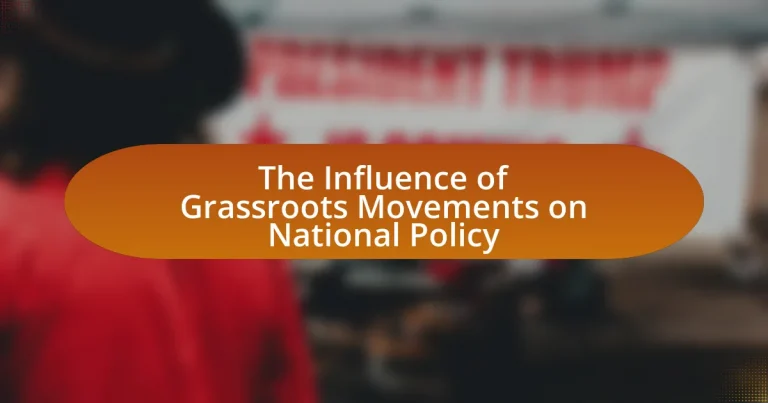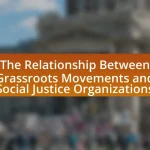Grassroots movements are organized efforts by ordinary citizens aimed at achieving social or political change, often influencing national policy. This article examines the mechanisms through which grassroots movements initiate change, including community mobilization, social media engagement, and coalition-building. It highlights historical examples such as the Civil Rights Movement and contemporary movements like Black Lives Matter, illustrating their significant impact on legislation and public opinion. Additionally, the article discusses the challenges these movements face, strategies for overcoming obstacles, and best practices for measuring their effectiveness in shaping national policy across various sectors, including environmental and social justice initiatives.
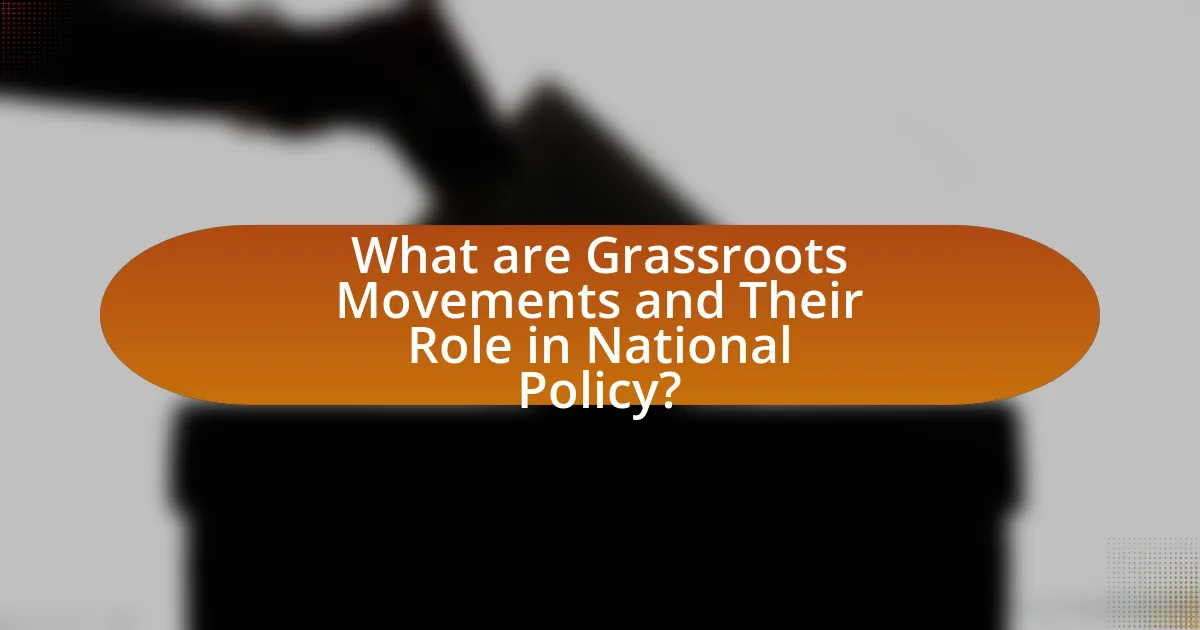
What are Grassroots Movements and Their Role in National Policy?
Grassroots movements are organized efforts by ordinary people to effect social or political change at the community level, often influencing national policy. These movements mobilize citizens around specific issues, such as civil rights, environmental protection, or healthcare reform, and can significantly impact legislation and government actions. For example, the Civil Rights Movement in the United States during the 1960s led to landmark legislation like the Civil Rights Act of 1964, demonstrating how grassroots activism can shape national policy. Additionally, contemporary movements like Black Lives Matter have raised awareness and prompted discussions on police reform and racial justice, illustrating their ongoing role in influencing national policy debates.
How do grassroots movements initiate change in national policy?
Grassroots movements initiate change in national policy by mobilizing community members to advocate for specific issues, thereby influencing public opinion and policymakers. These movements often utilize strategies such as organizing protests, leveraging social media campaigns, and building coalitions to amplify their message. For example, the Civil Rights Movement in the United States effectively used grassroots organizing to challenge segregation laws, leading to significant legislative changes like the Civil Rights Act of 1964. This demonstrates that grassroots movements can create substantial pressure on national leaders to enact policy reforms that reflect the demands of the populace.
What strategies do grassroots movements employ to influence policymakers?
Grassroots movements employ strategies such as mobilizing community engagement, leveraging social media, and forming coalitions to influence policymakers. Mobilizing community engagement involves organizing local events, rallies, and town hall meetings to raise awareness and demonstrate public support for specific issues, which can pressure policymakers to take action. Leveraging social media allows grassroots movements to disseminate information rapidly, engage a broader audience, and create viral campaigns that attract attention from both the public and decision-makers. Forming coalitions with other organizations amplifies their voice and resources, enabling them to present a united front on policy issues, which can lead to more significant influence over legislative agendas. These strategies have been effective in various movements, such as the Civil Rights Movement and more recent climate action initiatives, demonstrating their impact on shaping national policy.
How do grassroots movements mobilize community support?
Grassroots movements mobilize community support by fostering local engagement and building networks of individuals who share common goals. These movements often utilize strategies such as organizing community meetings, leveraging social media platforms for outreach, and creating awareness campaigns that resonate with local issues. For instance, the Black Lives Matter movement effectively mobilized support through social media, leading to widespread protests and policy discussions on racial justice. Research indicates that grassroots initiatives can significantly influence public opinion and policy changes, as seen in the 2018 March for Our Lives campaign, which advocated for gun control and successfully engaged thousands of young activists across the United States.
Why are grassroots movements significant in shaping public policy?
Grassroots movements are significant in shaping public policy because they mobilize community engagement and influence decision-makers through collective action. These movements often represent the interests and needs of marginalized groups, providing a platform for voices that might otherwise be overlooked in traditional political processes. For instance, the Civil Rights Movement in the United States effectively changed public policy by raising awareness and advocating for legislative reforms, such as the Civil Rights Act of 1964, which aimed to eliminate discrimination. Additionally, grassroots movements can leverage social media and technology to amplify their messages, mobilize supporters, and create pressure on policymakers, as seen in the global climate strikes initiated by youth activists. This ability to organize and advocate for change demonstrates the critical role grassroots movements play in shaping public policy.
What historical examples illustrate the impact of grassroots movements on national policy?
Grassroots movements have significantly influenced national policy throughout history, with notable examples including the Civil Rights Movement in the United States and the Women’s Suffrage Movement. The Civil Rights Movement, particularly from the 1950s to the 1960s, led to landmark legislation such as the Civil Rights Act of 1964 and the Voting Rights Act of 1965, which were direct responses to grassroots activism aimed at ending racial segregation and discrimination. Similarly, the Women’s Suffrage Movement culminated in the passage of the 19th Amendment in 1920, granting women the right to vote, a change driven by decades of grassroots organizing and advocacy. These movements demonstrate how collective action at the community level can lead to substantial changes in national policy.
How do grassroots movements differ from traditional lobbying efforts?
Grassroots movements differ from traditional lobbying efforts primarily in their approach to influence policy. Grassroots movements mobilize large groups of individuals at the community level to advocate for change, often relying on collective action and public engagement, whereas traditional lobbying involves direct interaction with policymakers by professional lobbyists representing specific interests or organizations.
For instance, grassroots movements often utilize social media and public demonstrations to raise awareness and build support, as seen in movements like Black Lives Matter, which gained traction through widespread public participation and online activism. In contrast, traditional lobbying typically involves formal meetings, financial contributions, and strategic communication aimed at persuading legislators, as exemplified by organizations like the American Medical Association, which employs lobbyists to advocate for healthcare policies directly.
This distinction highlights how grassroots movements emphasize broad public participation and community-driven initiatives, while traditional lobbying focuses on targeted influence through established political channels.
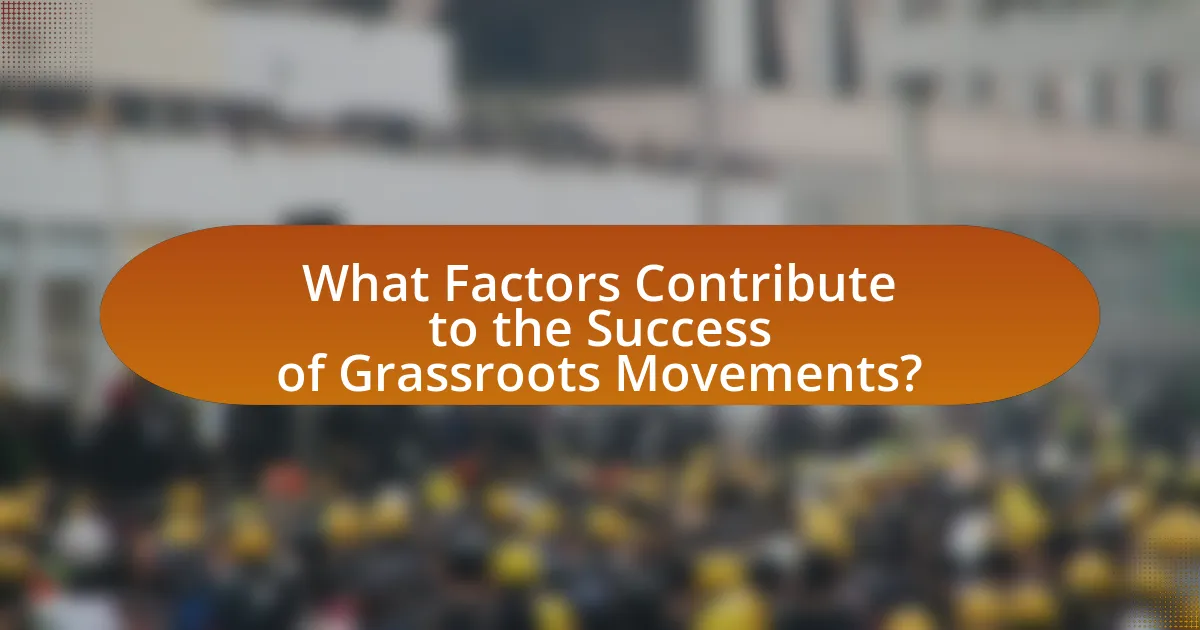
What Factors Contribute to the Success of Grassroots Movements?
The success of grassroots movements is primarily influenced by community engagement, effective communication, and strategic organization. Community engagement fosters a sense of ownership and commitment among participants, which is crucial for mobilizing support and sustaining momentum. Effective communication ensures that the movement’s goals and messages resonate with a broader audience, often utilizing social media platforms to amplify reach. Strategic organization involves planning and coordination of activities, which can include protests, petitions, and lobbying efforts, to create a structured approach toward achieving specific policy changes. Historical examples, such as the Civil Rights Movement in the United States, demonstrate how these factors combined to effect significant national policy changes, highlighting the importance of grassroots efforts in shaping public discourse and legislative outcomes.
How does public engagement affect the effectiveness of grassroots movements?
Public engagement significantly enhances the effectiveness of grassroots movements by increasing visibility, mobilizing resources, and fostering community support. When the public actively participates, it amplifies the movement’s message, leading to greater awareness and potential policy changes. For instance, the 2017 Women’s March, which drew millions globally, demonstrated how widespread public engagement can influence national discourse and prompt political action, ultimately impacting legislative agendas. Research indicates that movements with higher public involvement are more likely to achieve their goals, as seen in studies analyzing the correlation between public participation and successful policy outcomes.
What role does social media play in grassroots mobilization?
Social media serves as a crucial tool for grassroots mobilization by facilitating communication, organization, and engagement among supporters. It enables grassroots movements to rapidly disseminate information, coordinate events, and rally individuals around a common cause, often leading to increased participation and visibility. For instance, during the Arab Spring, social media platforms like Twitter and Facebook were instrumental in organizing protests and sharing real-time updates, which significantly contributed to the movements’ momentum and impact. This demonstrates that social media not only amplifies grassroots efforts but also enhances their effectiveness in influencing national policy.
How do grassroots movements build coalitions with other organizations?
Grassroots movements build coalitions with other organizations by identifying shared goals and values, which fosters collaboration. These movements often engage in outreach to like-minded organizations, facilitating discussions that highlight mutual interests and objectives. For example, the Civil Rights Movement in the 1960s successfully allied with labor unions and religious groups, amplifying their collective voice and resources. This strategic alignment not only enhances visibility but also strengthens advocacy efforts, as seen in the collaboration between environmental grassroots organizations and larger NGOs to influence climate policy. Such coalitions leverage diverse networks to mobilize support, share resources, and create a unified front, ultimately increasing their impact on national policy.
What challenges do grassroots movements face in influencing national policy?
Grassroots movements face significant challenges in influencing national policy, primarily due to limited resources and institutional barriers. These movements often operate with minimal funding and manpower, which restricts their ability to mobilize large-scale support or conduct extensive advocacy campaigns. For instance, a study by the National Democratic Institute found that grassroots organizations frequently struggle to compete with well-funded lobbyists and established political entities that have greater access to policymakers. Additionally, grassroots movements encounter institutional barriers such as bureaucratic red tape and a lack of representation in decision-making processes, which can hinder their efforts to effect change. These challenges are compounded by the need to build coalitions and maintain public engagement, which can be difficult in a rapidly changing political landscape.
How do political opposition and institutional barriers impact grassroots efforts?
Political opposition and institutional barriers significantly hinder grassroots efforts by limiting access to resources, reducing visibility, and obstructing policy influence. Grassroots movements often rely on public support and funding, which can be stifled by political entities that oppose their agendas. For instance, in the United States, the Tea Party movement faced substantial pushback from established political figures, which restricted its ability to mobilize effectively. Additionally, institutional barriers such as stringent regulations on campaign financing and lobbying can further complicate grassroots initiatives, as seen in the case of environmental movements that struggle against corporate lobbying efforts. These dynamics illustrate how political opposition and institutional constraints can undermine the effectiveness and reach of grassroots movements, ultimately affecting their capacity to influence national policy.
What strategies can grassroots movements use to overcome these challenges?
Grassroots movements can overcome challenges by employing strategies such as building coalitions, leveraging social media, and engaging in community organizing. Building coalitions allows grassroots movements to unite diverse groups, increasing their collective power and resources, as seen in the success of the Civil Rights Movement, where various organizations collaborated to amplify their impact. Leveraging social media enables movements to reach wider audiences quickly and efficiently, facilitating rapid mobilization and awareness, evidenced by the viral nature of campaigns like #MeToo. Engaging in community organizing fosters local support and empowers individuals, creating a strong base for advocacy, as demonstrated by the success of the Fight for $15 movement, which organized fast-food workers to demand higher wages. These strategies collectively enhance the effectiveness of grassroots movements in influencing national policy.
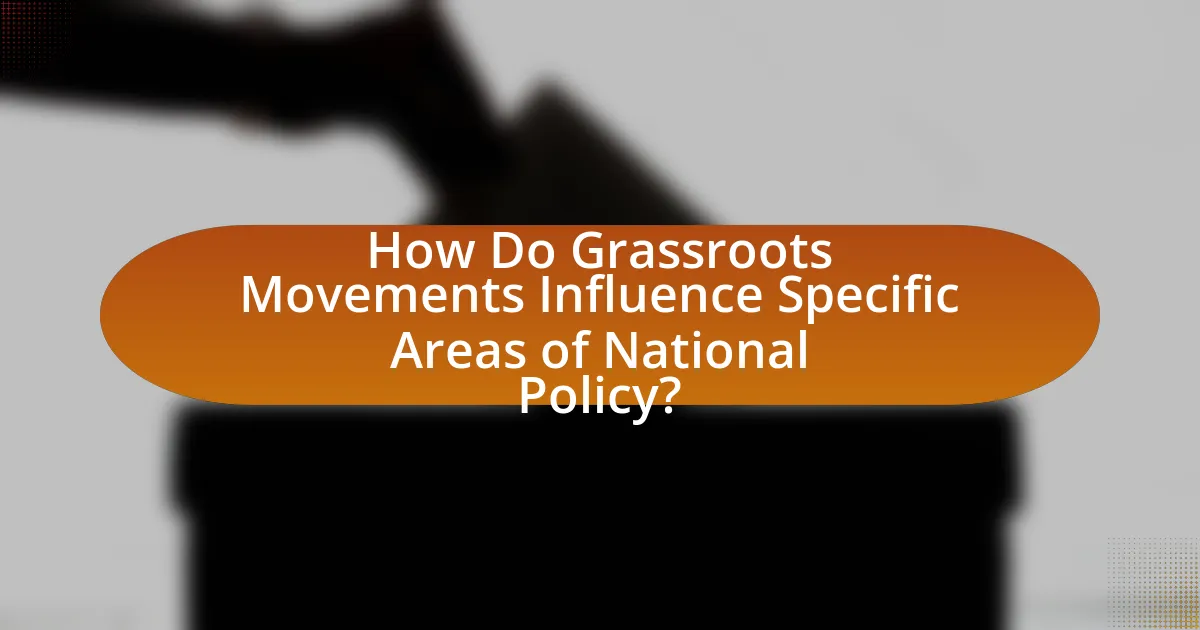
How Do Grassroots Movements Influence Specific Areas of National Policy?
Grassroots movements influence specific areas of national policy by mobilizing public support, raising awareness, and advocating for change through organized efforts. These movements often focus on issues such as environmental protection, social justice, and healthcare reform, effectively shaping policy agendas. For instance, the Civil Rights Movement in the 1960s led to significant legislative changes, including the Civil Rights Act of 1964, demonstrating how grassroots activism can directly impact national policy. Additionally, the rise of social media has amplified grassroots efforts, allowing for rapid dissemination of information and mobilization of supporters, as seen in movements like Black Lives Matter, which has influenced discussions on policing and racial equity at the national level.
What are the key policy areas affected by grassroots movements?
Grassroots movements significantly affect key policy areas such as environmental policy, social justice, healthcare reform, and education policy. For instance, the environmental movement has led to the implementation of policies like the Clean Air Act and the Clean Water Act, driven by public advocacy for sustainable practices. Social justice movements, such as Black Lives Matter, have influenced police reform and civil rights legislation, highlighting systemic inequalities. In healthcare, grassroots campaigns have pushed for universal healthcare access, exemplified by the Affordable Care Act in the United States. Additionally, grassroots efforts in education have resulted in policy changes regarding funding and curriculum reforms, emphasizing equity and access for marginalized communities. These movements demonstrate the power of collective action in shaping national policy across various sectors.
How have grassroots movements shaped environmental policy?
Grassroots movements have significantly shaped environmental policy by mobilizing public support, raising awareness, and influencing legislative change. For instance, the environmental movement of the 1960s and 1970s, exemplified by events like Earth Day, galvanized public concern over pollution and conservation, leading to landmark legislation such as the Clean Air Act of 1970 and the Clean Water Act of 1972 in the United States. These movements often utilize grassroots organizing tactics, such as community engagement and advocacy campaigns, to pressure policymakers and hold them accountable. The success of initiatives like the Sierra Club’s campaigns against deforestation and climate change demonstrates how grassroots efforts can lead to substantial policy shifts, reflecting the collective voice of concerned citizens in shaping a sustainable future.
What influence do grassroots movements have on social justice initiatives?
Grassroots movements significantly influence social justice initiatives by mobilizing community members to advocate for systemic change. These movements often raise awareness about social injustices, galvanizing public support and pressuring policymakers to address issues such as racial inequality, gender rights, and economic disparities. For instance, the Black Lives Matter movement has effectively highlighted police brutality and racial discrimination, leading to legislative discussions on police reform in various states. Additionally, grassroots organizations often provide a platform for marginalized voices, ensuring that the needs and perspectives of affected communities are represented in social justice dialogues. This direct engagement fosters a sense of ownership and empowerment among community members, which is crucial for sustaining long-term advocacy efforts.
How do grassroots movements impact public opinion and legislative action?
Grassroots movements significantly influence public opinion and legislative action by mobilizing community engagement and raising awareness on specific issues. These movements often utilize social media and local organizing to amplify their messages, which can shift public perceptions and create a sense of urgency around particular topics. For instance, the Black Lives Matter movement has reshaped discussions on racial justice and police reform, leading to legislative proposals in various states aimed at addressing systemic racism. Research indicates that grassroots advocacy can lead to increased voter turnout and pressure on lawmakers, as seen in the 2018 midterm elections where youth-led movements contributed to higher participation rates. This demonstrates that grassroots efforts can effectively translate public sentiment into actionable policy changes.
What methods do grassroots movements use to sway public opinion?
Grassroots movements use various methods to sway public opinion, including community organizing, social media campaigns, and public demonstrations. Community organizing involves mobilizing individuals at the local level to raise awareness and build support for specific issues, effectively creating a collective voice that can influence broader public sentiment. Social media campaigns leverage platforms like Twitter and Facebook to disseminate information rapidly, engage with supporters, and create viral content that resonates with a wider audience. Public demonstrations, such as protests and rallies, visually showcase the movement’s strength and urgency, drawing media attention and prompting public discourse. These methods have been proven effective; for instance, the Women’s March in 2017 mobilized millions globally, significantly impacting discussions around women’s rights and policies.
How do successful grassroots campaigns lead to legislative changes?
Successful grassroots campaigns lead to legislative changes by mobilizing public support and influencing policymakers through organized advocacy efforts. These campaigns often utilize strategies such as community engagement, social media outreach, and coalition-building to raise awareness about specific issues, thereby creating a strong constituency that demands action. For example, the 2018 March for Our Lives movement, initiated by students advocating for gun control, successfully pressured lawmakers to consider new legislation, resulting in various states enacting stricter gun laws. This demonstrates how grassroots efforts can translate public sentiment into legislative action, effectively shaping national policy.
What Best Practices Can Grassroots Movements Adopt for Greater Impact?
Grassroots movements can adopt several best practices for greater impact, including building strong community networks, leveraging social media for outreach, and engaging in strategic partnerships. Strong community networks enhance collective action and mobilization, as evidenced by the success of movements like Black Lives Matter, which effectively organized local chapters to amplify their message. Leveraging social media allows grassroots movements to reach wider audiences quickly; for instance, the #MeToo movement utilized platforms like Twitter to raise awareness and foster global conversations about sexual harassment. Engaging in strategic partnerships with established organizations can provide additional resources and credibility, as seen in the collaboration between environmental groups and indigenous communities to advocate for climate justice. These practices collectively enhance the effectiveness and reach of grassroots movements in influencing national policy.
How can grassroots movements effectively measure their impact on national policy?
Grassroots movements can effectively measure their impact on national policy by utilizing quantitative and qualitative metrics, such as policy changes, public opinion shifts, and legislative engagement. For instance, tracking the number of bills introduced or amended in response to grassroots advocacy provides concrete evidence of influence. Additionally, surveys and polls can quantify changes in public sentiment regarding specific issues championed by these movements, demonstrating their ability to shape national discourse. Historical examples, such as the Civil Rights Movement, show that grassroots efforts led to significant legislative changes, including the Civil Rights Act of 1964, which can be directly linked to organized advocacy and public mobilization.
What are the most effective communication strategies for grassroots movements?
The most effective communication strategies for grassroots movements include leveraging social media, building community networks, and utilizing storytelling. Social media platforms enable grassroots movements to reach a wide audience quickly, facilitating engagement and mobilization. For instance, the #BlackLivesMatter movement effectively used Twitter and Instagram to raise awareness and organize protests, demonstrating the power of digital communication in grassroots activism. Building community networks fosters trust and collaboration, allowing movements to amplify their message through local leaders and organizations. Additionally, storytelling humanizes issues, making them relatable and compelling; movements like the LGBTQ+ rights campaign have successfully used personal narratives to garner support and influence public opinion. These strategies collectively enhance visibility, engagement, and impact, proving essential for the success of grassroots movements in shaping national policy.
